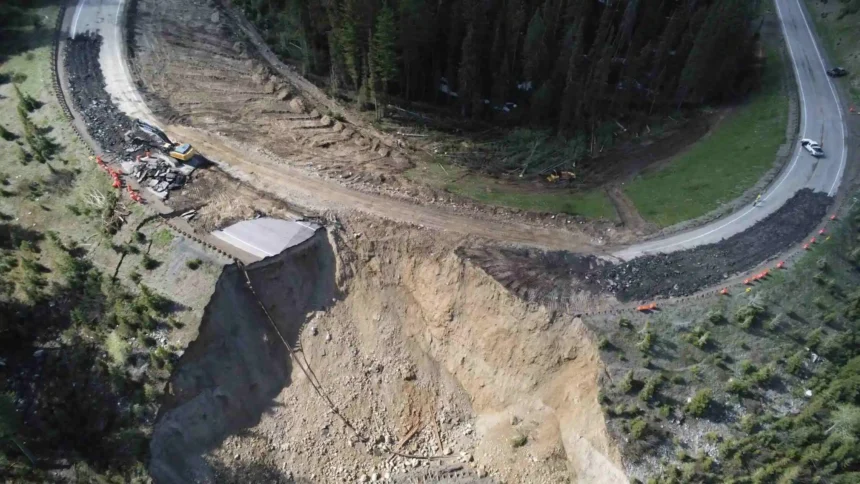Between June 6 and June 8, 2024, a major Teton Pass landslide happened, Wyoming, causing a big part of State Highway 22 to collapse at milepost 12.8.
The landslide started quickly, with cracks appearing in the road on June 6, getting worse due to heavy rain and fast snow melting.
By June 8, the road was completely destroyed, cutting off a key route between Jackson, Wyoming, and Victor, Idaho. Luckily, no one was hurt.
Immediate Impact of the Landslide
Teton Pass landslide isolated the main route between Jackson in Wyoming and Victor in Idaho.
This led to a longer journey, which would deter anyone commuting to work or taking a holiday in places such as Jackson Hole, Yellowstone, or Grand Teton National Park, whereby they would cover an additional 85 miles in about 2 hours.
That is why the road closure became one of the key reasons why people could not receive proper medical assistance in time.
The Role of Weather in the Landslide
Before the Teton Pass landslide, the area had a lot of rain and fast snow melting, making the ground unstable.
The weather was 10-20 degrees warmer than usual, causing snow to melt quickly. This made the soil very wet and weak.
The wet soil and the extra weight from the water made the slopes press down harder, causing the landslide.
This kind of weather is happening more often, making experts worried about landslides in places like Teton Pass, which are already at risk.
Geological Factors Behind the Landslide
Teton Pass is made up of a mix of rocks, including metamorphic, igneous, and sedimentary, formed by past tectonic movements and glaciers.
The main rock type is ancient gneiss, formed under high heat and pressure, with layers of older sedimentary rocks around it.
The area has experienced major uplift, leading to its steep landscape and fault lines. Landslides often happen due to steep slopes, soft soil, and heavy rain or snow, which can weaken the rocks.
The Response from Authorities
After a major Teton Pass landslide on June 8, 2024, the Wyoming Department of Transportation (WYDOT quickly acted to fix the problem.
Governor Mark Gordon declared an emergency, which allowed the state to get more help and resources from the Federal Highway Administration for quick fixes.
WYDOT sent teams to check the damage and started building a temporary road around the landslide at milepost 12.8.
They hired Evans Construction for $430,000 to speed up the work. The agency’s experts are looking into why the landslide happened to plan for long-term fixes.
Safety was a top priority, making sure no workers were hurt or equipment was damaged, and keeping people informed about road conditions and detour paths.
The Construction of a Temporary Detour
After the Teton Pass landslide on State Highway 22, a temporary route around the Teton Pass was set up, about 600 feet long, with two lanes for lighter vehicles.
This route keeps Jackson, Wyoming, and Victor, Idaho connected but takes longer, about 1 hour and 35 minutes instead of 30 minutes.
To keep everyone safe, the Wyoming Department of Transportation (WYDOT) has set a 20 mph speed limit because the road is steeper.
Drivers must follow all signs and be careful, especially with construction work improving drainage to prevent future landslides and make sure the detour is safe.
Long-term Solutions and Repairs
After the Teton Pass landslide The Wyoming Department of Transportation (WYDOT) plans to permanently repair State Highway 22 on Teton Pass by rebuilding the mountain instead of moving the road, which is cheaper and quicker.
They’ve started improving a temporary detour to reduce disruptions. The U.S. Department of Transportation has given $6 million for this project, seeing it as crucial for workers and visitors.
Governor Mark Gordon has promised state help, focusing on reconnecting communities and making the area’s infrastructure stronger for future weather challenges.
The Economic Impact of the Closure
The Teton Pass landslide has greatly affected local economies, especially tourism, by cutting off an important route between Jackson, Wyoming, and Victor, Idaho.
Initial estimates show that this closure is costing Teton County, Idaho, commuters about $600,000 every day, with more time spent traveling and higher costs.
Businesses, especially those that depend on tourists, have seen a big decrease in customers, with some, like gas stations, losing up to 900 customers daily.
The long-term impact could be serious, as the area’s economy relies heavily on tourism, and any ongoing problems could make visitors less likely to come, affecting both seasonal income and jobs.
The Teton Pass landslide shows how dangerous it is for important systems in mountains and stresses the importance of taking steps to deal with the dangers of severe weather. As the area deals with the impact of the closure, it’s dealing with big economic problems that need to be fixed quickly.



